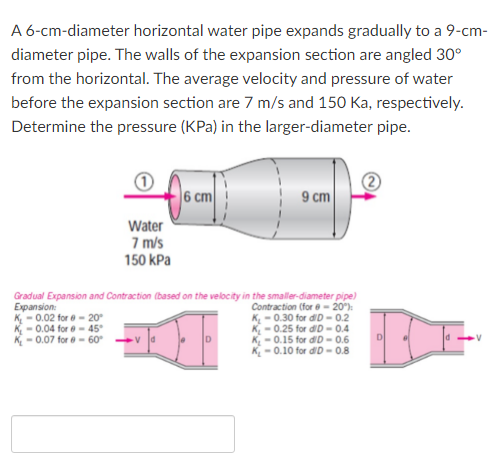A 6-cm-diameter horizontal water pipe expands gradually to a 9-cm- diameter pipe. The walls of the expansion section are angled 30° from the horizontal. The average velocity and pressure of water before the expansion section are 7 m/s and 150 Ka, respectively. Determine the pressure (KPa) in the larger-diameter pipe. 6 cm 9 cm Water 7 m/s 150 kPa
A 6-cm-diameter horizontal water pipe expands gradually to a 9-cm- diameter pipe. The walls of the expansion section are angled 30° from the horizontal. The average velocity and pressure of water before the expansion section are 7 m/s and 150 Ka, respectively. Determine the pressure (KPa) in the larger-diameter pipe. 6 cm 9 cm Water 7 m/s 150 kPa
Elements Of Electromagnetics
7th Edition
ISBN:9780190698614
Author:Sadiku, Matthew N. O.
Publisher:Sadiku, Matthew N. O.
ChapterMA: Math Assessment
Section: Chapter Questions
Problem 1.1MA
Related questions
Question
100%
A 6-cm-diameter horizontal water pipe expands gradually to a 9-cm-diameter pipe. The walls of the expansion section are angled 30° from the horizontal. The average velocity and pressure of water before the expansion section are 7 m/s and 150 Ka, respectively. Determine the pressure (KPa) in the larger-diameter pipe.

Transcribed Image Text:A 6-cm-diameter horizontal water pipe expands gradually to a 9-cm-
diameter pipe. The walls of the expansion section are angled 30°
from the horizontal. The average velocity and pressure of water
before the expansion section are 7 m/s and 150 Ka, respectively.
Determine the pressure (KPa) in the larger-diameter pipe.
6 cm
9 cm
Water
7 m/s
150 kPa
Expansion:
K, - 0.02 for e- 20
K, - 0.04 for e - 45°
K- 0.07 for e- 60
Gradual Expansion and Contraction (based on the velocity in the smaller-diameter pipe)
Contraction (for e - 20):
K, - 0.30 for diD - 0.2
K, -0.25 for d'D - 0.4
K, -0.15 for diD - 0.6
K, -0.10 for dD- 0.8
Expert Solution
This question has been solved!
Explore an expertly crafted, step-by-step solution for a thorough understanding of key concepts.
This is a popular solution!
Trending now
This is a popular solution!
Step by step
Solved in 3 steps with 3 images

Knowledge Booster
Learn more about
Need a deep-dive on the concept behind this application? Look no further. Learn more about this topic, mechanical-engineering and related others by exploring similar questions and additional content below.Recommended textbooks for you

Elements Of Electromagnetics
Mechanical Engineering
ISBN:
9780190698614
Author:
Sadiku, Matthew N. O.
Publisher:
Oxford University Press

Mechanics of Materials (10th Edition)
Mechanical Engineering
ISBN:
9780134319650
Author:
Russell C. Hibbeler
Publisher:
PEARSON

Thermodynamics: An Engineering Approach
Mechanical Engineering
ISBN:
9781259822674
Author:
Yunus A. Cengel Dr., Michael A. Boles
Publisher:
McGraw-Hill Education

Elements Of Electromagnetics
Mechanical Engineering
ISBN:
9780190698614
Author:
Sadiku, Matthew N. O.
Publisher:
Oxford University Press

Mechanics of Materials (10th Edition)
Mechanical Engineering
ISBN:
9780134319650
Author:
Russell C. Hibbeler
Publisher:
PEARSON

Thermodynamics: An Engineering Approach
Mechanical Engineering
ISBN:
9781259822674
Author:
Yunus A. Cengel Dr., Michael A. Boles
Publisher:
McGraw-Hill Education

Control Systems Engineering
Mechanical Engineering
ISBN:
9781118170519
Author:
Norman S. Nise
Publisher:
WILEY

Mechanics of Materials (MindTap Course List)
Mechanical Engineering
ISBN:
9781337093347
Author:
Barry J. Goodno, James M. Gere
Publisher:
Cengage Learning

Engineering Mechanics: Statics
Mechanical Engineering
ISBN:
9781118807330
Author:
James L. Meriam, L. G. Kraige, J. N. Bolton
Publisher:
WILEY